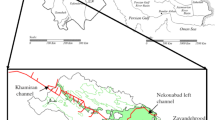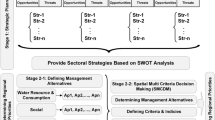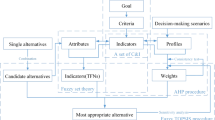Abstract
The technical and socioeconomic evaluation of small-scale sprinkler irrigation systems is a multi-criteria problem characterized by complexity and uncertainty. In order to solve that, the application of Grey Relational Analysis (GRA) was presented. An evaluation model with ten sub-criteria under four groups, namely, technical, economic, environmental and social, was established. Among the criteria, calculation method of labor use in the small-scale sprinkler systems was originally addressed, and Life Cycle Cost (LCC) was used as an economic indicator. In the design of GRA, a combination weighting method based on Analytical Hierarchy Process (AHP) and entropy measurement was employed to take into account the experts’ knowledge and the inherent information in the experimental data. Six irrigation systems for three field sizes 0.5 ha, 2 ha and 5 ha respectively were considered to verify the model. The systems were optimized with Genetic Algorithms (GAs) first to figure out the optimal combinations of sprinklers and pipes and further, field tests were performed. The discussions show that: the developed approach has successfully provided the ranking of systems for three field sizes. When different types of sprinklers are used, the criteria including atomize index, application efficiency and specific energy consumption change greatly. And the ownership cost, particularly the energy consumption fee, accounts for the largest part of LCC in most of the systems. In comparison, System 5 and System 1 are generally the best. The evaluation model solved by GRA integrated with GAs is effective and can be extended to the comprehensive evaluation and optimization of other irrigation systems.





Similar content being viewed by others
References
Abhang LB, Hameedullah M (2012) Determination of optimum parameters for multi-performance characteristics in turning by using grey relational analysis. Int J Adv Manuf Technol. doi:10.1007/s00170-011-3857-6
Akay D (2011) Grey relational analysis based on instance based learning approach for classification of risks of occupational low back disorders. Safety Sci 49:1277–1282
Aslan N, Shahrivar AA, Abdollahi H (2012) Multi-objective optimization of some process parameters of a lab-scale thickener using grey relational analysis. Sep Purif Technol 90:189–195
Atisa G, Bhat MG, McClain ME (2014) Economic assessment of best management practices in the Mara River Basin: toward implementing payment for watershed services. Water Resour Manag 28(6):1751–1766
Brown CJ, Vearil J, Linton P, Hendren T, Whittle G (2014) A multi-criteria assessment of the C-111 hydrologic restoration project – a case study. Water Resour Manag 28(9):2453–2469
Burt CM, Clemmens AJ, Strelkoff TS, et al (1997) Irrigation performance measures: efficiency and uniformity. J Irrig Drain Eng-ASCE 123 (6). doi:10.1061/(ASCE)0733-9437(1997)123:6(423)
Chen D, Webber M, Chen J, Luo Z (2011) Energy evaluation perspectives of an irrigation improvement project proposal in China. Ecol Econ 70:2154–2162
Comas J, Connor D, Isselmou MEM, Mateos L, Gómez-Macpherson H (2012) Why has small-scale irrigation not responded to expectations with traditional subsistence farmers along the Senegal River in Mauritania? Agr Syst 110:152–161
Datta S, Bandyopadhyay A, Pal PK (2008) Grey-based taguchi method for optimization of bead geometry in submerged arc bead-on-plate welding. Int J Adv Manuf Technol 39:1136–1143
Deng JL (1986) Grey forecasting and decision-making. Huazhong Institute of Technology Press, Wu Han.
Du YL, Xu DJ (2011) Standard operating time of the primary building-fireman indoor. Fire Sci Technol 30(1):79–81
Garg M, Cascarini L, Coombes DM et al (2010) Multicentre study of operating time and inpatient stay for orthognathic surgery. Brit J Oral Max Surg 48:360–363
Grusse PHLE, Mailhol JC, Bouaziz A et al (2009) Indicators and framework for analysing the technical and economic performance of irrigation systems at farm level. Irrig Drain 58:S307–S319
Halwatura RU, Jayasinghe MTR (2009) Influence of insulated roof slabs on air conditioned spaces in tropical climatic conditions- a life cycle cost approach. Energ Build 41:678–686
Jiménez A, Ríos-Insua S, Mateos A (2006) Using a combination of weighting methods in multiattribute decision-making. Oper Res Proc Vol 2005, 2006:767–772
Kalita HM, Sarma AK, Bhattacharjya RK (2014) Evaluation of optimal river training work using GA based linked simulation-optimization approach. Water Resour Manag 28(8):2077–2092
Karmakar S, Mujumdar PP (2007) A two-phase grey fuzzy optimization approach for water quality management of a river system. Adv Water Resour 30:1218–1235
Khan ZA, Kamaruddin S, Siddiquee AN (2010) Feasibility study of use of recycled High Density Polyethylene and multi response optimization of injection moulding parameters using combined grey relational and principal component analyses. Mater Des 31:2925–2931
Li SY (1995) Sprinkler nozzle theory and design. Ordnance Industry Press, Beijing
Mateos L (2006) A simulation study of comparison of the evaluation procedures for three irrigation methods. Irrig Sci 25:75–83
Michailidis A, Mattas K, Tzouramani I, Karamouzis D (2009) A socioeconomic valuation of an irrigation system project based on real option analysis approach. Water Resour Manag 23:1989–2001
Montazar A, Zadbagher E (2010) An analytical hierarchy model for assessing global water productivity of irrigation networks in Iran. Water Resour Manag 24(11):2817–2832
Montazar A, Gheidari ON, Snyder RL (2013) A fuzzy analytical hierarchy methodology for the performance assessment of irrigation projects. Agr Water Manag 121:113–123
Morankar DV, Raju KS, Kumar DN (2013) Integrated sustainable irrigation planning with multiobjective fuzzy optimization approach. Water Resour Manage 27(11):3981–4004
Moreno MA, Ortega, Co’rcoles JI, Martinez A, Tarjuelo JM (2010) Energy analysis of irrigation delivery systems: monitoring and evaluation of proposed measures for improving energy efficiency. Irrig Sci 28:445–460
Niu HZ, Liu ZD, Jia YM (2010) Influence of groundwater depth on evapotranspiration and water requirement coefficient of spring maize. J Irrig Drain 29(4):110–113
Rao R, Yadava V (2009) Multi-objective optimization of Nd:YAG laser cutting of thin superalloy sheet using grey relational analysis with entropy measurement. Opt Laser Technol 41:922–930
Ribeiro I, Peças P, Henriques E (2012) Comprehensive model to evaluate the impact of tooling design decisions on the Life Cycle Cost and environmental performance. 19th CIRP International Conference on Life Cycle Engineering, Berkeley, 2012
Rodrigues GC, Paredes P, Goncalves JM, Alves I, Pereira LS (2013) Comparing sprinkler and drip irrigation systems for full and deficit irrigated maize using multicriteria analysis and simulation modelling: ranking for water saving vs. farm economic returns. Agr Water Manag 126:85–96
Srivastava RC, Mohanty S, Singandhuppe RB et al (2010) Feasibility evaluation of pressurized irrigation in canal commands. Water Resour Manag 24:3017–3032
Tu Q, Wang XK, Li H (2012) Optimization of sprinkler irrigation machine based on Genetic Algorithms. ASABE Annual International Meeting, Dallas, Texas. Paper No.:12–1341121
Tzanakakis K (2013) The railway track and its long term behaviour. Springer-Verlag Berlin, Heidelberg
Wang ZH, Zhan W (2012) Dynamic engineering multi-criteria decision making model optimized by entropy weight for evaluating bid. Syst Eng Proc 5:49–54. doi:10.1016/j.sepro.2012.04.008
Wang XK, Yuan SQ, Zhu XY, Tu Q (2010) Optimization of light-small movable unit sprinkler system using Genetic Algorithms based on energy consumption indicators. Trans CSAM 14(10):58–62
Zhai LY, Khoo LP, Zhong ZW (2009) Design concept evaluation in product development using rough sets and grey relation analysis. Expert Syst Appl 36:7072–7079
Zheng H, Wang Z, Hu S, Wei Y (2012) A comparative study of the performance of public water rights allocation in China. Water Resour Manag 26:1107–1123
Zooho K, Vijay PS (2014) Assessment of environmental flow requirements by entropy-based multi-criteria decision. Water Resour Manag 28(2):459–474
Acknowledgments
This work is contributed by the National Hi-Tech Research & Development Program (863 Program)- Precision sprinkler irrigation technologies and products (No. 2011AA100506), Jiangsu Scientific Research and Innovation Program for Graduates in the Universities - Fixed-mobile Duple-purpose Hose Sprinkler Irrigation System Based on Minimum Energy Consumption and Best Water Distribution (No. CXZZ11_0565).
Author information
Authors and Affiliations
Corresponding author
Appendix
Appendix
Labor use (Operation time)
The operation time of a small-scale sprinkler irrigation system can be calculated using Eq. (16) in reference to the formula of manufacture time involved in the fire-fighting (Du and Xu 2011) and surgery (Garg et al. 2010).
where, T p represents the operation time of irrigation system on each location, min; k 1 is coefficient of experience of workers; k 2 is coefficient of weather condition, temperature and humidity for instance, influencing the efficiency of workers; k 3 is the coefficient related to the muddy ground; p is the number of components, or items included; i indicates the i-th part, including the operation time of pump and motor, pipes, sprinklers and walking time in the field; T i is the operation time for the i-th part, min. All the time is summarized according to experiences and statistical data in field tests and the questionnaire among users.
-
(1)
Pump and motor
The operation time spent on the pump and motor T m includes three items: carrying them to the water source, connecting the suction pipe and checking the parts before start.
-
(2)
Pipes
The time for laying and connecting the delivery pipes, T d shown in Eq. (17) can be divided into two parts: the operation time and walking time for transportation.
$$ {T}_d= n\left[{T}_{d1}\left(1+{k}_d\right)+{T}_{d2}\right] $$(17)$$ {T}_{d2}={k}_t{t}_d a $$(18)where, Td1 is the operation time for each pipe connecting two sprinklers; kd is coefficient related to pipe diameter; Td2 is walking time for allocating and installing the pipes, min; kt is coefficient of walking times, k = 1, 2, for the initial time, k = 2, others, k = 1; td is the walking time per meter, min.
-
(3)
Sprinklers
The operation time of sprinklers T s can be described with Eq. (19).
$$ {T}_s= n{T}_{s0} $$(19)where, T s0 is the operation time for each set of sprinkler, riser pipe and supporter, min.
-
(4)
Walking time or transportation time
The walking time or transportation time in distributing the sprinklers, pipes and couplings is related to the area of the field in each irrigation event. Supposing all the facilities are placed at one end of the field while the end sprinkler is arranged at the other end. The walking time T l is then presented:
$$ {T}_l={t}_d\frac{n\left( n-1\right)}{2} a $$(20)The coefficients used in these equations are listed in Table 9 (Du and Xu 2011).
Table 9 Values of coefficients
Rights and permissions
About this article
Cite this article
Tu, Q., Li, H., Wang, X. et al. Multi-Criteria Evaluation of Small-Scale Sprinkler Irrigation Systems Using Grey Relational Analysis. Water Resour Manage 28, 4665–4684 (2014). https://doi.org/10.1007/s11269-014-0765-1
Received:
Accepted:
Published:
Issue Date:
DOI: https://doi.org/10.1007/s11269-014-0765-1




